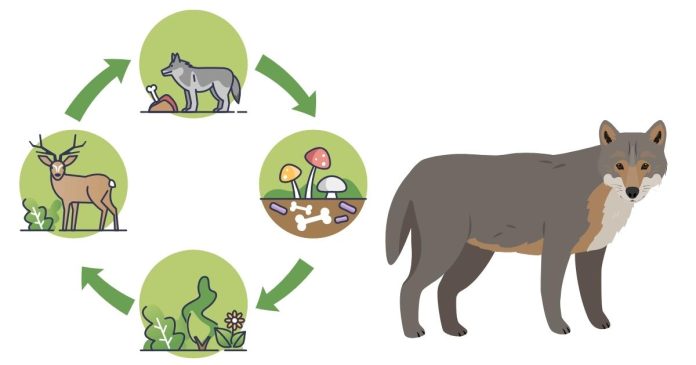Wolves are classified as apex predators, meaning they are at the very top of the food chain in their ecosystems. Let’s break this down in more detail:
1. Trophic Levels:
In an ecosystem, the food chain is typically structured in trophic levels. These levels represent different positions in the food chain based on the organism’s role in energy transfer. Here’s a basic structure:
- Producers (plants and algae) at the bottom.
- Primary consumers (herbivores that eat plants) like deer, rabbits, and other herbivorous animals.
- Secondary consumers (carnivores that eat herbivores) such as foxes and smaller predators.
- Tertiary consumers (apex predators) that are at the top, such as wolves, bears, and big cats.
Wolves are at the tertiary consumer level, or in many cases, they function as apex predators.
2. Role in the Ecosystem:
As apex predators, wolves play a critical role in maintaining the balance of their ecosystems by controlling the population of herbivores. By hunting and killing animals like deer, elk, or moose, wolves prevent overgrazing and allow vegetation to thrive. This process, known as trophic cascades, helps regulate the whole ecosystem, affecting everything from plant life to smaller predators.
3. Hunting Behavior:
Wolves typically hunt in packs, which gives them a strategic advantage over larger prey like elk or bison. The pack hunts cooperatively, using tactics that ensure they can take down prey much larger than an individual wolf could manage. Their prey usually consists of large ungulates (hoofed mammals), such as:
- Deer (white-tailed, mule)
- Elk
- Moose
- Bison (in some regions) They may also hunt smaller animals when larger prey is scarce, such as beavers, rabbits, or even smaller predators.
4. Competition:
While wolves are apex predators, they do face competition from other carnivores in their environment, especially in areas where there are other large predators. For example:
- Bears (grizzly bears or black bears) may sometimes scavenge wolf kills or, in rare cases, hunt wolves.
- Mountain lions (cougars) may compete for similar prey and have been known to come into conflict with wolves, though the two predators usually avoid direct confrontation.
However, wolves often dominate in hunting strategy, especially when hunting in a pack, whereas many of their competitors tend to hunt alone.
5. Predation on Wolves:
As apex predators, adult wolves have very few natural predators. However, certain circumstances could lead to wolves becoming prey:
- Bears may attack wolf pups, especially if they stumble upon a den.
- Humans are by far the most significant threat to wolves due to habitat destruction, hunting, and conflicts with livestock.
- Other wolves: In some cases, rival wolf packs or individual wolves might challenge a pack, leading to territory disputes or even attacks.
6. Ecological Impact:
Wolves have an important indirect impact on their environment. For instance, in Yellowstone National Park, the reintroduction of wolves in 1995 dramatically altered the local ecosystem. Wolves helped control the elk population, which allowed overgrazed areas to regenerate. This in turn benefited plant life, and over time, led to improvements in the populations of smaller animals, birds, and even beavers.
7. Energy Flow and Biomagnification:
Wolves also play a part in energy flow. They consume large amounts of meat, which is transferred up the food chain when they are consumed by scavengers (e.g., ravens, eagles, foxes, etc.). After wolves die, their carcasses provide sustenance for other species like scavengers or decomposers (fungi, bacteria). Thus, the energy that once went into the wolf is distributed throughout the ecosystem.
Conclusion:
Wolves are not only apex predators in their food chain, but they also help regulate their ecosystems in complex and vital ways. Their position at the top allows them to control populations of other species, ensuring balance and promoting biodiversity. While their primary role is predation, they indirectly shape their entire environment, influencing everything from plant growth to other species’ behaviors. This makes them a keystone species—an organism whose presence and activity have a disproportionate impact on its ecosystem.


